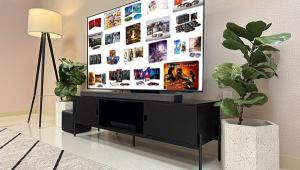6 Cheap Ways to Improve Sound Quality

Move Your Speakers: Except for on-walls, most speakers are not designed to sit close to a wall. So the single best tweak for your audio system is getting the speakers away from walls and corners. Try moving them two to three feet from the wall. Notice how imaging suddenly tightens up? With a speaker that has meaningful bass response, you may also notice a tightening of the bass. Also, your speakers should not be parallel with the wall. Experiment with toeing in toward the listening position. If you want the speakers to service more than a single sweet spot, try toeing out to various degrees. Oh, and make sure all tweeters, including the center, are at ear level, so that lateral pans won't jump up or down.
Control Reflections: Hard surfaces may make for a handsome modern room but they're hell on audio systems. Check out the slap echo by clapping your hands and listening for reflections. If you hear a loose, sloppy reverb, you have work to do. Cover most of the floor with a rug with a thick pad under the rug. Then add absorptive or diffusive elements to the side and back walls. Acoustic treatments don't have to be unsightly. In fact, they don't have to be acoustic treatments per se. Shelves of records or other media work well. Maybe this would be a good time to talk to Grandpa about his record collection. If you live in the post hard copy media era, fill the shelves with flea market books or anything that absorbs or diffuses sound waves. You needn't cover the entire wall, only the spots responsible for first reflections. One way to identify them is to sit a confederate down in the sweet spot and move a hand mirror around the wall until your friend can see the speaker in the mirror. Mark the first-reflection spots with Post-It notes and treat them. Here's a primer on locating reflections and treating them with homemade acoustic panels.
Basic Speaker Cable Upgrade: I'm not talking about the fancy high-priced stuff here. Just thicker stuff. If your speakers are communicating through skinny zip cord, they might be happier with thicker zip cord. Upgrade all your speaker cables to 12-gauge (12 AWG). Cheap generic stuff is fine. Thicker cable is more appropriate for long runs to begin with (like those to your surround speakers). And because the high frequencies travel toward the outside of the conductor, a thicker conductor will give them more room to move. The audible effect of thicker speaker cable is more of everything good.
Basic Interconnect Cable Upgrade: One of the powered speakers that I use for casual non-audio-critical TV viewing recently started emitting a howling storm of noise. I wiggled all the connections, swapped the channels, connected the speakers to something else, and concluded that my TV's analog audio output was on the fritz. One thing I didn't think to try until later was to change the cable. It turned out there was never anything wrong with the TV. The cheap cable's plugs had corroded and were strangling the signal. So whether or not you're into higher-priced audio interconnects, any cable in your system has to meet basic standards. Like, conducting a signal without severely polluting it. Some of the cheap interconnects in your system may need to be replaced from time to time, either permanently with slightly better corrosion-proof cable, or temporarily with other cheap interconnects.
Better Sound from Your Computer: If a computer is one of your favorite music sources, you can improve performance by bypassing the internal soundcard's digital-to-analog convertor and upgrading to a higher-quality DAC that connects to a USB jack. A good USB DAC will reclock the chaotic bitstream coming from the computer and smooth out timing errors. Among the better low-cost USB DACs are the AudioQuest DragonFly v1.2 (the original model is also not too shabby) and the AudioEngine D3, both of which sell online for less than $150. They are tiny, so you can use them at home or on the go, and they handle files with resolution up to 24/96. Even if you're not into high-res audio, a good USB DAC can improve CD-quality or even lossy MP3 or AAC (iTunes) files. Whether you listen to a computer through headphones or an audio system, a small investment in a USB DAC can make an audible difference.
Better Sound from Your Phone: Even the lowliest smart (or dumb) phone can perform better with decent headphones. So toss the earbuds that came with your phone and treat yourself to, let's say, the Grado SR60e ($79). This on-ear model and its venerable predecessor the SR60 have been the entry point to good sound for generations of listeners. If you prefer buds, the InnerFidelity Wall of Fame has suggestions starting at $25 for the Xiaomi Piston 2.
What free or cheap audio upgrades would you recommend to your fellow readers in the comments section below?
Audio Editor Mark Fleischmann is the author of Practical Home Theater: A Guide to Video and Audio Systems, now available in both print and Kindle editions.













































